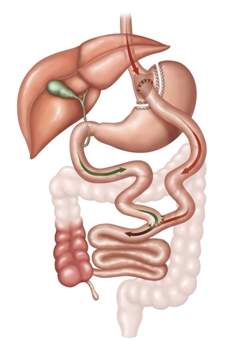Roux-en-Y Gastric Bypass
It is considered to be the "gold standard" procedure based on the recognized long term outcome and its effects on weight loss.
There are two components to this procedure. First a small stomach "pouch", approximately one ounce or 30 milliliters in volume, is created. Next the small intestine is divided downstream and the distal end of the divided small intestine is brought up and connected to the newly created stomach "pouch."
The Gastric Bypass works by several mechanisms. First the newly created smaller stomach "pouch" provides smaller available volume for meals that can be eaten, which translates to lower calorie consumption. Additionally there is a segment of the small intestine that (prior to the procedure) absorbs calories as food moves through, post procedure food no longer travels through that segment of the intestine, therefore calorie absorption is reduced. Most importantly the rerouting of the food stream produces changes in your gut's hormones that are responsible for suppressing hunger and can reverse one of the primary mechanisms which causes type 2 diabetes.
Advantages:
- Produces significant long-term weight loss (60 to 80 percent of excess body weight)
- Produces favorable changes in gut hormones that provides resolution of type 2 diabetes
- Most effective in resolving heartburn or gastroesophageal reflux disease
Disadvantages:
- Is technically a more complex operation in comparison to the sleeve gastrectomy and potentially could result in greater complication rates such as leak, ulcers, or internal hernia
- Can lead to long-term vitamin and/or mineral deficiencies, particularly vitamin B12, iron, calcium, and folate deficits





